My Orchid Cymbidium was doing fine until this spring, when it started displaying black spots, which looked suspicious!
I knew the bright direct light did not cause it because it was always kept under indirect sunlight.
Hence, it did not take much time to figure out that my beloved plant was under severe duress.
You could tell it by seeing the black or brown spots, smudges, or darkening foliage, but not all problems exhibit the same signs.
Read on to learn more about the causative agents of black spots in the Orchid plant and how to treat them.
Table of Contents Show
Can Excess Black Spots on Leaves Kill Orchids?
The unusual black or dark spots on Orchid leaves, and smudges may indicate the onset of a big problem because that is unlike the appearance of Orchids.
Orchid comes from rainforests with a tropical to temperate environment and boasts about 28,000 species worldwide.
Remember, black patches on cymbidium Orchid leaves indicate black rot, which will increase and may even kill the plant if left untreated.
Bacterial and fungal infection is usual with improper lighting, overwatering, low humidity, pest problems, and compromised plant health.
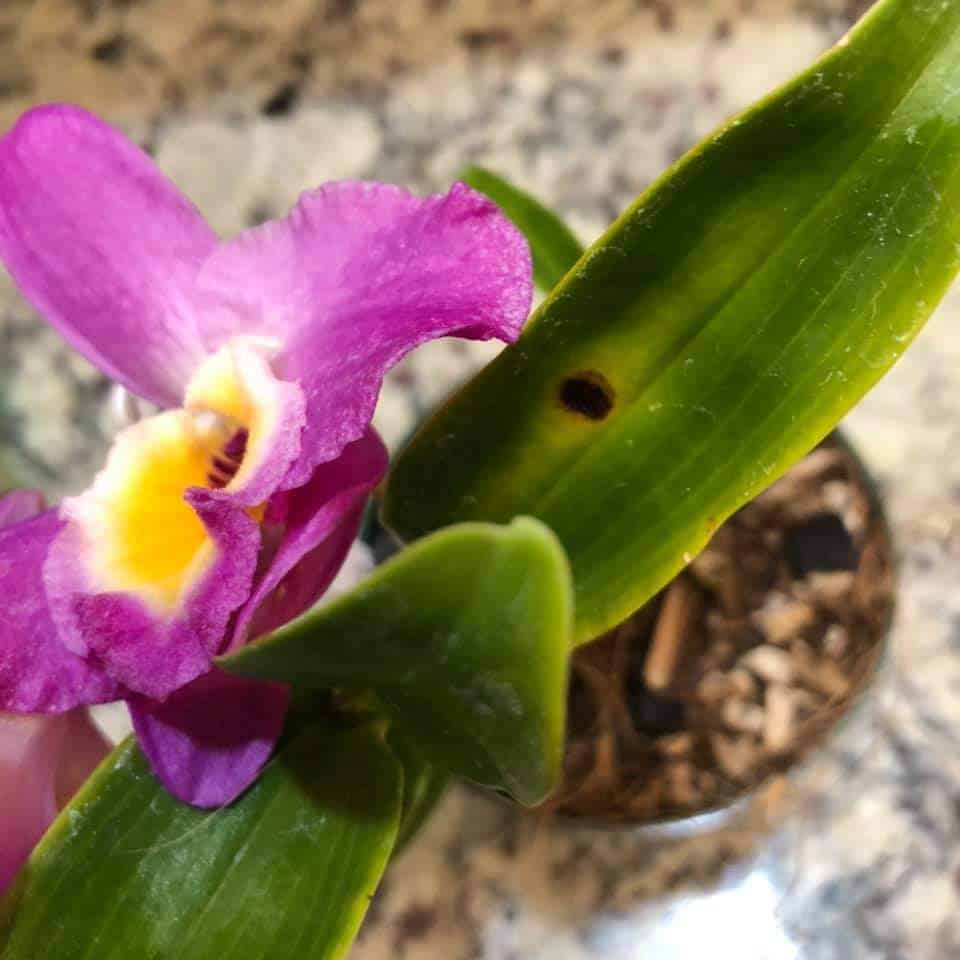
Although some round black spots on Orchid leaves are not considered dangerous, excessive dark proliferation means your plant is dying from root rot.
Overly blackened leaves cannot be revived, but you can restore the plant’s appearance with appropriate remedial measures.
It will snatch the vital energy and nutrients that would otherwise help boost greener leaves and a healthy appearance.
The best way to prevent black spots is to keep your Orchid healthy!
How to Identify Black Spots on Orchids?
It may be easier to figure out black spots on Orchids as the vivid-looking leaves quickly lose vigor.
Here are the tell-tale signs of black spots on Orchids and their causative agents.
- The Orchids suffering from root rot will exhibit leaves that may turn yellow around the infected area and feel soft to the touch, especially spots caused by fungus and bacteria.
- When pressed, the infected area oozes sappy liquid.
- It will appear as dark or black spots that take over 1/3 of the leaf size. The black spots enlarge rapidly and begin spreading to other leaves.

- Dark spots are caused by bright lighting, and bacterial brown spots may appear tiny in size with brownish spots that later turn black.
- If the black spots appear as elongated smudges, they are likely Guignardia Leaf Spots, also known as fungal leaf spots.
- Occasionally, leaf spots may leave yellowing leaves with tiny brown spots.
If the black rot reaches the crown of a monopodial (single-stemmed) Orchid, it will kill the plant.
These signs may require a further diagnosis to determine the exact problem.
How to Treat Black Spots on Orchid Leaves (6 Causes & Solutions)
Orchids respond quickly to the change in environment by exhibiting unusual signs, where a black spot on leaves is one of them. The primary step in treating your Orchid’s black spots is diagnosing the problem.
Let’s review the quick overview table, which shows the causative agents and the symptoms.
| Reasons for Black Spots | Symptoms |
|---|---|
| Overwatering | Tips of leaves turning brown and later black |
| Bacterial Infection | Wet lesions will appear that turn black |
| Fungal Infestation | Discolored leaves with tan or black spots |
| Extreme Temperature | Brittle and brown or black spots |
| Pest Infestation | Small holes and tiny black spots |
| Age Decline | Old and discolored leaves with slight blackening |
Let us look at the possible causes of black spots in Orchid plants.
1. Overwatering and Water Quality
Start ruling out overwatering issues because it is often the major contributor to black spots in Orchids.
Orchid does not like sitting in a pool of water and is more likely to attract soil-borne fungi, leading to root rot.
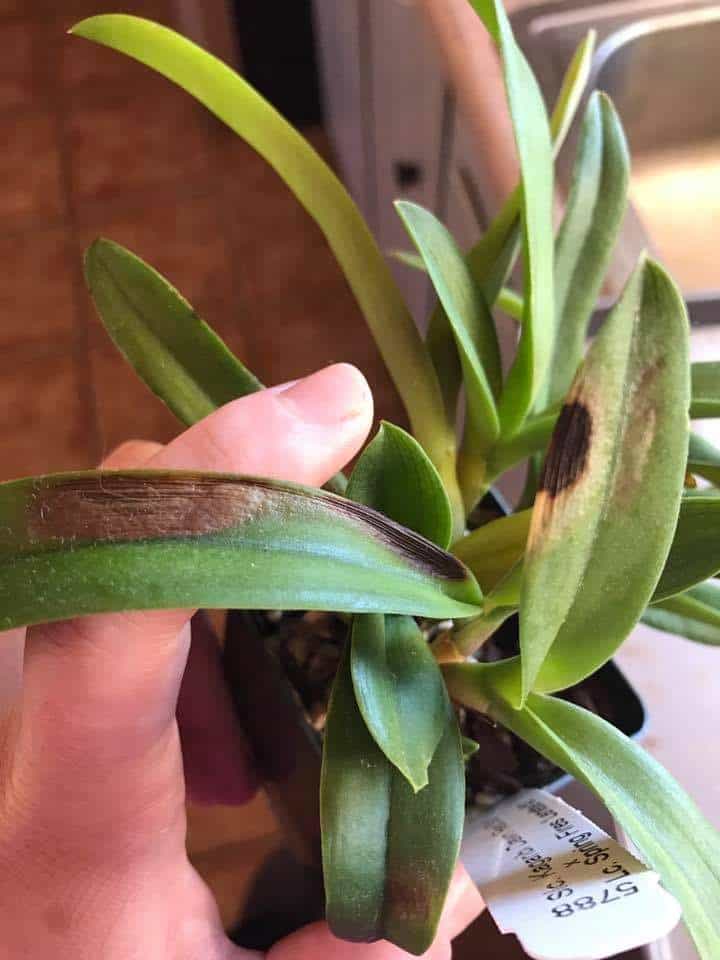
However, remember that the plant has irreversible rot and cannot be saved by this stage.
Of these two, water quality is of the least concern but not completely damage-free!
Solutions
- Cut back on watering and slide the plant out to check for visible root damage, such as dark, mushy, and smelly.
- If the damage seems minimal, prune it away before applying fungicide and repotting in a fresh soil mix.
- Dispose of the Orchid with severe root rot.
- Follow a stricter watering schedule and use a soil moisture meter to assess the soil moisture every week or before watering.
- Always use tepid and tap water or rainwater collected in a pot 12 hours before to moisten the Orchid potting soil.
2. Bacterial Infections
One of the most typical causes of black spots on Orchid leaves is the onset of bacterial disease. Bacterial leaf spots and soft rot are more common in Orchid plants.
a. Bacterial Leaf Spot
Bacterial leaf spot is familiar among Orchids left in damp or moist conditions.
You would notice small (less than 0.25 inch) water-soaked leaf spots on older leaves.
These lesions quickly turn black. As the disease proliferates, numerous lesions may appear, causing the leaves to collapse.
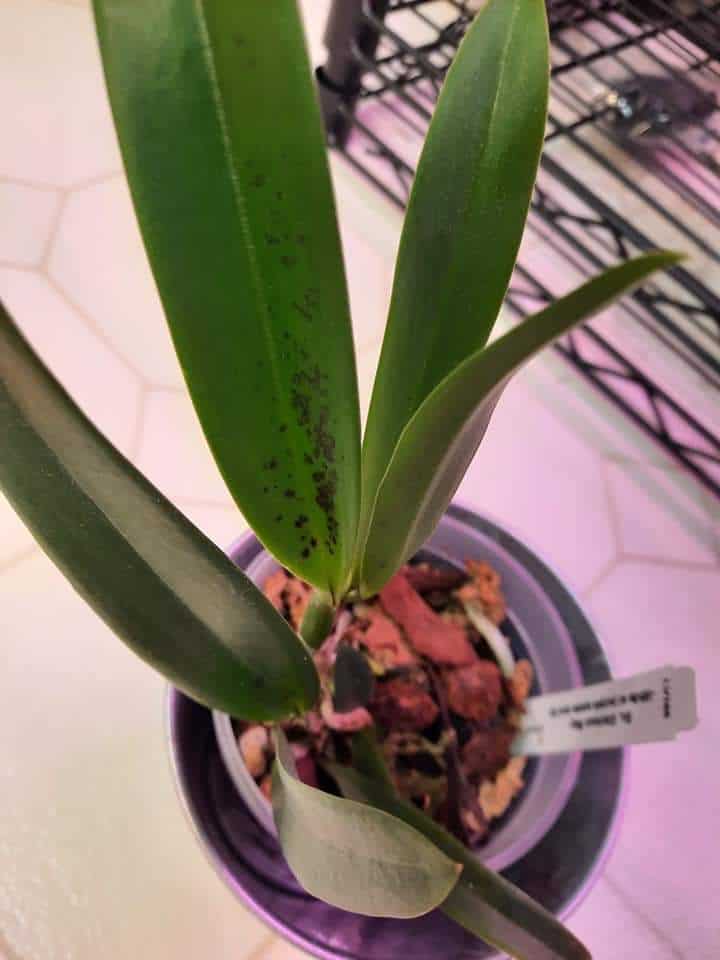
b. Bacterial Soft Rot
Bacterial soft rot is another cause of black spots on Orchid leaves.
The pathogens secrete enzymes that decompose cell wall structures, destroying the plant tissue.
Moreover, temperature extremities and highly humid conditions may also result in soft rot diseases.
The pathogen associated with soft rot disease survives and quickly spreads from diseased to healthy plants under such conditions.
Although more prevalent in food crops, infected houseplants may spread bacterial soft rot to the Orchid plant.
Solutions
- Start quarantining the infected plant and do not reintroduce them to other plants until fully treated.
- Trim the leaves with black spots using the sterilized pruning shear and dispose of them immediately.
- Move the plant to an open location with better air circulation and a temperature between 65-80°F.
- Apply 3% Hydrogen Peroxide on a cotton swab and dab the infected area.
- Applying copper fungicide will help treat bacterial lead spots and soft rot.
- You can also apply Cinnamon fungicide to the infected area.
3. Fungal Infection
Orchid plants grown at home are prone to fungal infestation caused by infected plants and improper trimming.
a. Black Rot
Black rot, also known as crown and heart rot, is a common cause of black spots on Orchid leaves, which may have devastating results.
These fungi boast zoospores that can swim through the water and penetrate the plant tissue when water happens to be sitting on the Orchid leaf.

You would mostly notice black smudge, which proliferates throughout the leaf.
b. Fungal Crown Rot
Fungal crown rot is another cause of root rot in Orchids and black spots on the leaves.
The infected areas may look discolored with tan or dark colors like black spots.
The worst thing about fungal crown rot is that the plant may die within weeks if untreated on time.
Solutions
- Remove the diseased portion and healthy tissue surrounding the area using a sterile knife.
- As an organic method, apply some grounded cinnamon to the infected parts.
- Otherwise, apply chemical pesticides like Agri-Mycin if the infestation looks worse.
- You can pour hydrogen peroxide into the infected area. Repeat the treatment every 2-3 days.
c. Fungal Leaf Spots
Fungal leaf spot, primarily caused by Phyllosticta capitalensis and Guignardia, is another cause of black spot on Orchid leaves.
It spreads quickly and causes unsightly blemishes on Orchid leaves. The fungal leaf spot disease is most prevalent in hotter climates.
Spots frequently combine to form large irregular lesions that can cover a large portion of the leaf.
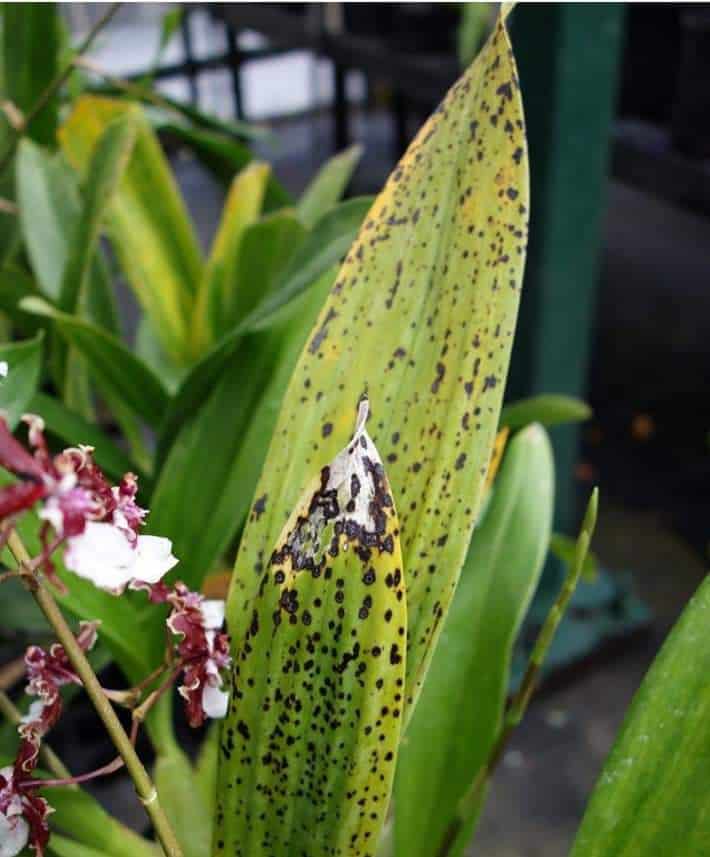
Solutions
- Prune away infected leaves and safely dispose of them.
- Spray the plant with fungicides like thiophanate methyl and a protectant fungicide like Mancozeb, Dithane M45, Captan, and Ferbam.
- Apply them repeatedly every 2-3 weeks following the label instructions.
4. Extreme Temperature and Sunburn
Extreme temperature and bright lighting will excessively transpire the leaves, leading to water loss.
It is indicated by low-humidity stress that causes dry spots and dark patches on Orchid leaves.
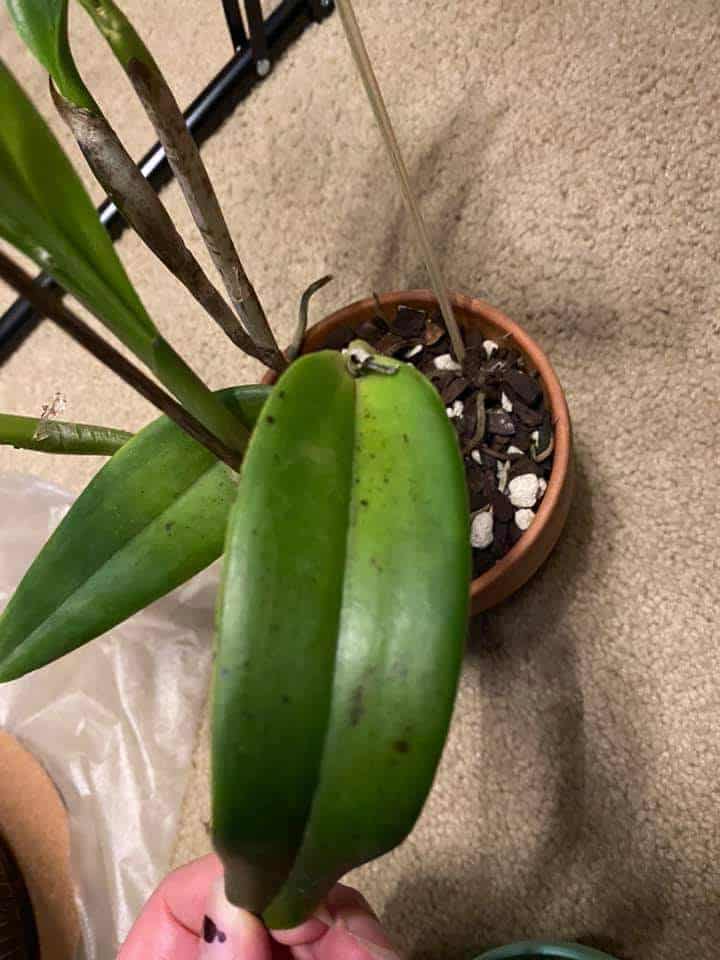
Check for brittle and brown or black spots on Orchid leaves.
Sunburn is another cause of the blackening of Orchid leaves, which can even become brown and crispy around the edges when severely scorched.
However, do not mistake these for a diseased Orchid plant.
Solutions
- Move your Orchid away from direct sunlight or brightly lit areas, such as close to the south-facing window.
- Trim the leaves with excessive blackening (Over 50%), brownish patches, and holes.
- Place the plant in a pebble tray filled with water to soak the moisture naturally.
- Mist the leaves with tepid water a couple of times a week to boost the humidity level around the plant.
- Otherwise, move it indoors beside other houseplants or a room humidifier.
5. Pest Infestation
Although rare, the black spots on Orchid leaves may be the byproduct of pest infestation.
You heard it right! Pest invasion of the houseplants is not uncommon, especially when bringing the infected plant home.

| Pests | Effects of Infestation | Diagnosis |
|---|---|---|
| Aphids | Cricket-like creatures with back legs that suck up saps from the plant leaves and stems. | Especially abundant on stems and buds with higher nitrogen concentration |
| Mealy Bugs | They eat the leaves sap, causing stunted and deformed development. | Seen on new growth, leaf veins, and leaf joints |
| Scale Insects | Drains important plants sap, weakening them and causing their leaves to be yellow and fall off. | Found on plant stems, twigs, trunks, foliage, or fruit |
| Spider Mites | Causing leaves to turn yellow, brown, or gray and drop off. | Reside on the undersides of plant leaves, where they weave silky webs around tree leaves and stems |
| Thrips | Suck out plant's juice and leaves may appear pale, splotchy, and silvery before dying. | Found on the leaves or stems of plants, as well as in the petals of flowers. |
Most pest infestations begin with contaminated potting soil, where the pest eggs would hatch larvae upon receiving a favorable environment.
As these larvae invade the plant’s shoots and leaves, they begin sucking the sap, leaving tiny black spots around the infected leaves.
Solutions
- To avoid further damage, deadhead all the infected parts, including leaves and stems.
- Use Neem oil to apply all over the plant to organically remove the pests and their eggs.
- Otherwise, dip cotton in 75% diluted isopropyl alcohol and rub the infected parts.
- Use tweezers or your fingers to pick up the visible pests and drop them in the soapy water solution.
- Apply chemical pest repellants like Malathion or Pyrethrin spray if the problem persists.
Related article; How to Identify Insect Eggs on Leaves and Treat Pest Infestation?
6. Age Decline
The Orchid plant will regularly decommission old, discolored, and worn-out leaves.
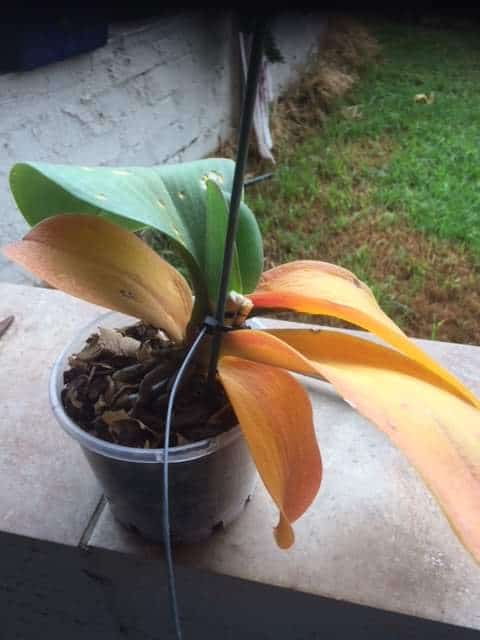
However, it does not mean your plant is infected or drying from a disease.
Start with diagnosing whether the infected leaves appear at the bottom half and the sighting of black spots.
Old, discolored leaves are prevalent in the bottom half as they are first to come and first to go, and you may only witness a few blackening leaves.
Solutions
- Prune your Orchid foliage regularly to give it a clean.
- Remove dark, brown, dry, and wrinkled-looking leaves.
- Check the bottom half for old and decayed leaves, which have to go.
- Wash your plant with clean water or Neem oil several times in the growing season to keep it looking tidy.
How to Prevent Black Spots on Orchid Leaves?
Here are some tips to help avoid black spots in an Orchid plant.
- Start with scheduling watering and moisture level to avoid the risk of overwatered plants and root rot.
- Most Orchid species require watering every 5-10 days during spring and summer when the soil base is 90% dry.
- A soil moisture meter before watering should read no more than 4 or 5.
- Use a room humidifier to maintain an ideal humidity level around the plant. Orchids do best in a humidity range between 40-70%.
- Orchid prefers a light range from 380-430nm, best provided by dappled sunlight in an east-facing location or a few feet away from the south-facing window.
- Ensure the temperature stays between 65-80°F (18.3-30°C) throughout the growing period. Otherwise, move your plant under LED grow light in fall and winter.
- Clean Orchid leaves a couple of times in spring and summer with a soapy water solution or Neem oil to prevent pest and bacterial disease.
- Change soil appropriately and prioritize drainage using a mix rich in peat moss, perlite, fine bark, chips, and vermiculite.
- Quarantine a newly bought plant for at least two weeks before introducing it to other houseplants.
Final Thoughts!
Infected and sick Orchids are more likely to exhibit black spots on the foliage, which is a significant tell-tale sign.
Upon discovering this tell-tale sign, diagnose the problem with your Orchid using this guide.
When loved and cared for, your Orchid will display healthy green foliage and lush blossoms yearly.
Follow this plant guide to diagnose your Orchid plant’s issues before it becomes unsalvageable.


